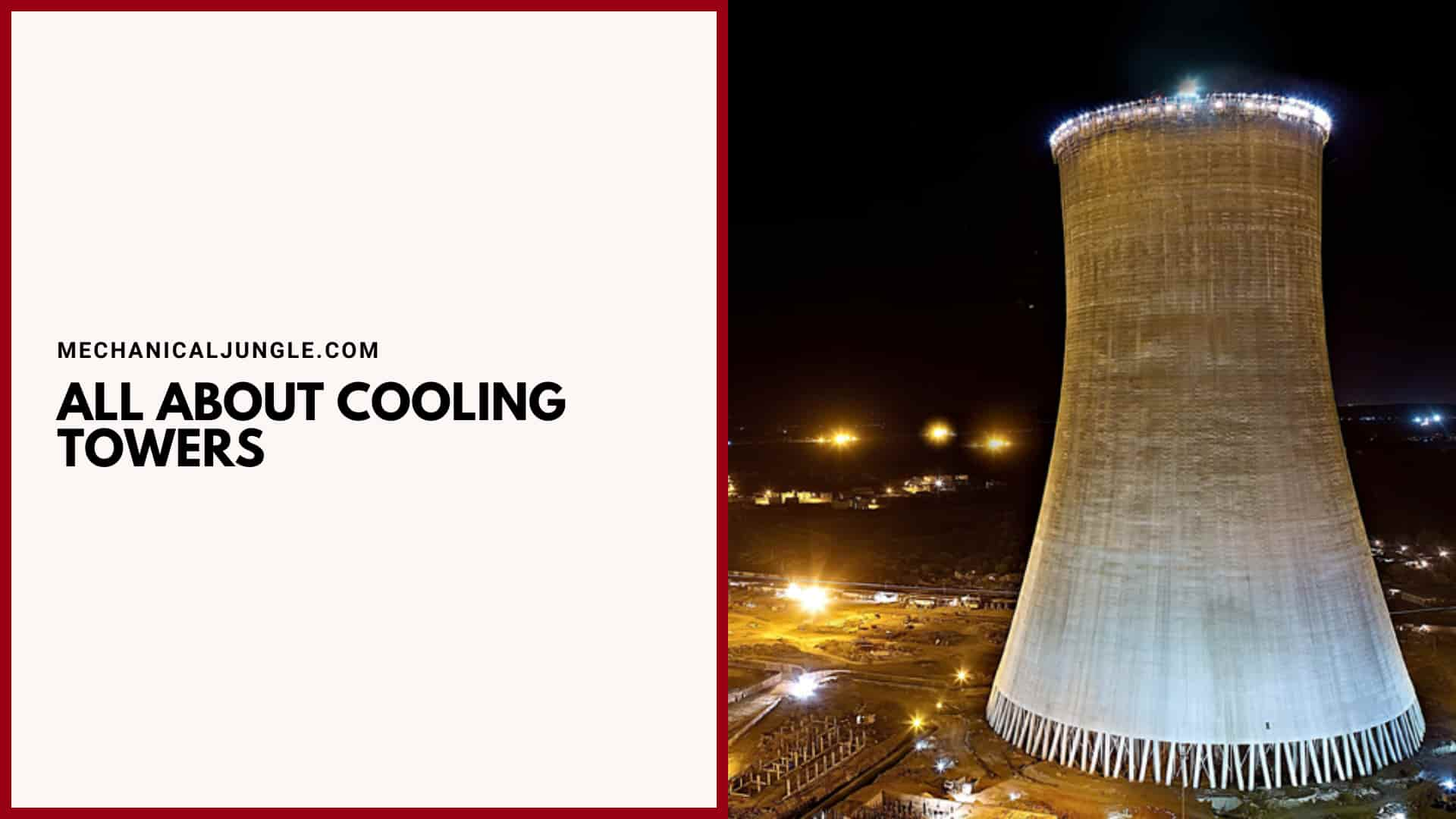
What Is Cooling Towers?

Water, which has been heated by an industrials process or an air conditioning condenser, is pumped through the pipe into the cooling tower.
Water circulates through nozzles on the coast of a material called “fill,” which slows down the flow of water through the cooling tower & exposes as much water surface area as possibles for maximum air-to-water contact.
As the waters flow through the cooling tower, it is exposed to air, which is being pulled through the tower by an electric motor-driven fan. When water and air meet, a small amount of water evaporates, leading to a cooling action.
The cooling waters are then pumped back into the condensers or process types of equipment, where it absorbs heat. It will then be pumped backs to the cooling towers once again to cool.
Cooling Towers Fundamentals provides a level of basic cooling tower knowledge and is a great resource for those wanting to learn more.
Industrial cooling towers are an effective way of transporting unwanted heat from one place to another using water, where transport media is used in applications where cold water is in the temperature range of 70 ° F to 100 ° F. Must be a reliable source.
Cooling towers are commonly used for cool products, including injection molding, tools and die-cutting, food and beverage, chemicals, lasers, machine tools, semiconductors, and more in a multitude of applications.
While there are different manufacturers using different designs, all cooling towers operate using the same principle of evaporative cooling.
Working of Cooling Towers:
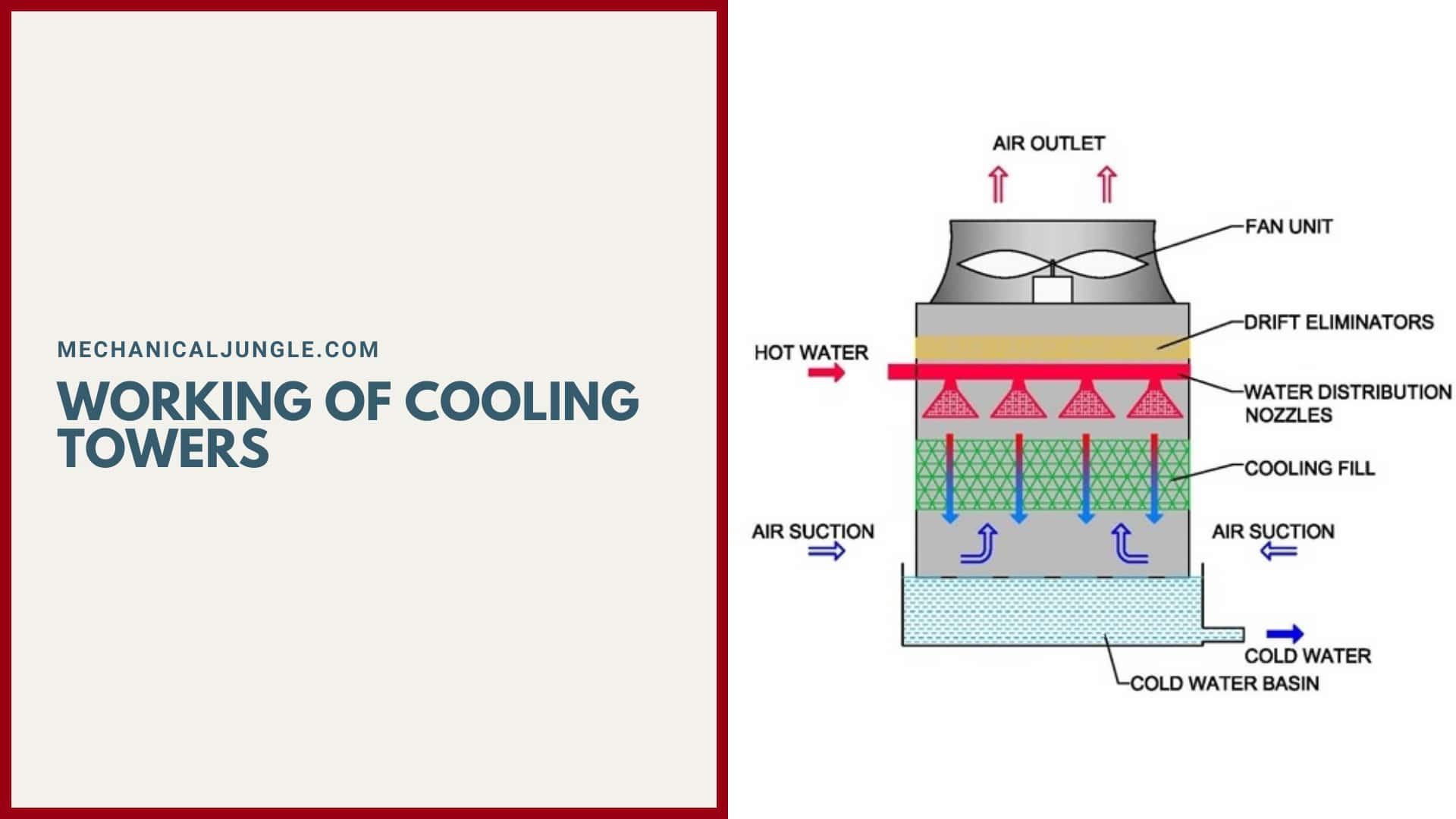
Hot water from power plants or industries circulates on the fils (heat exchanging surface) through nozzles connected to hot water pipes. Fills have a hexagonal cavity over them that allows the diffusing water to slowly move down. And the air from the bottom of the cooling tower moves upwards and fills.
When air and hot water come in contact with each other, air takes latent heat from the water and cools it. The air takes heat from the water, so it becomes hot, and due to this, it evaporates some water and cools the water further.
As we all know that evaporation gives a cooling effect, i.e., where evaporation occurs on the surfaces from which evaporation is cooling. After cooling the hot water, the air moves upward with evaporated water.
Above the hot water pipe, we have a drift eliminator. The drift eliminator cools most of the water vapor and prevents it from escaping from the cooling tower. Some water vapor that is too low may escape. The hot air finishes the flow and escapes from the cooling tower.
Some of you may wonder why thises is going to end the drift, so I will tell you so this remover is reducing the water loss from the cooling tower. As the water is filled, it gets colder and colder, and finally, it gets collected in the basin.
And from the basin, the cooling water is circulated to the condenser of the power plant and industrial machinery for the purposes of re-cooling. The circulation of water inside and outside the cooling tower is done using centrifugal pumps.
Types of Cooling Towers:
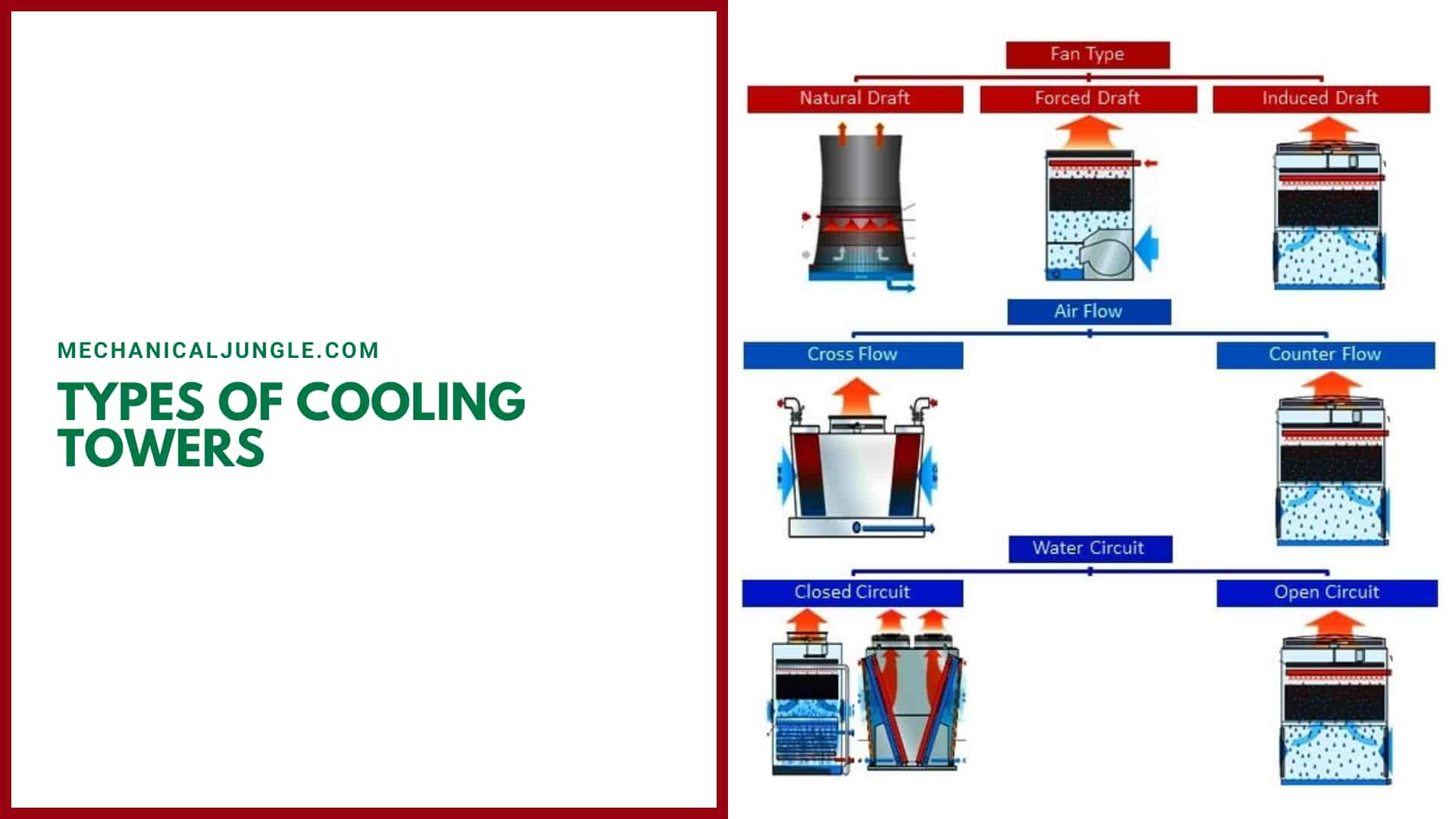
Cooling tower systems are often important for industrial processes. These elongated, open-ended, cylindrical structures are responsible for the cooling water generated by industrial or HVAC comfort cooling airflows.
They are classified by the types of the draft (natural or mechanical) and the direction of airflow (counter or cross).
#1. Natural Draught Cooling Tower
In this type of cooling tower, the fan is not used to circulate air, but here, it is used to enclose the hot air in the chimney, and this will cause the hot air and the surrounding air. A pressure difference will arise. These pressure differences cause air to enter the cooling tower.
This requires a larger hyperbolic tower, so capital costs are higher, but operating costs are lower in the absence of an electric fan. There are two types of natural draft cooling towers, rectangular wooden towers S and reinforced concrete hyperbolic towers.
#2. Forced Draught Cooling Tower
In such a cooling tower, the fan is used to circulate air. When a power plant operates at peak load, it requires a large amount of cold water.
To rotate the fan, it uses a motor with a speed of about 1000 rpm. The working principle is similar to the natural draft cooling tower, the only difference being that the fan is placed on the cooling tower here.
If the fan is mounted on the top of the tower, an induced draft is called the cooling tower, which is most popular for installation of very large capacity and requires a large capacity of the fan.
So, the forced draft cooling tower has a horizontal shaft for the fan and is placed under the tower, and the induced draft cooling tower has a vertical shaft and is placed on top of the cooling tower.
#3. Mechanical Draft Cooling Tower
Air is forced through the structure by the fan, which transmits air through the tower. Common fans used in these towers include propeller fans and centrifugal fans.
While mechanical draft towers are more effective than natural draft towers, as a result, they consume more power and cost.
#4. Crossflow Cooling Tower
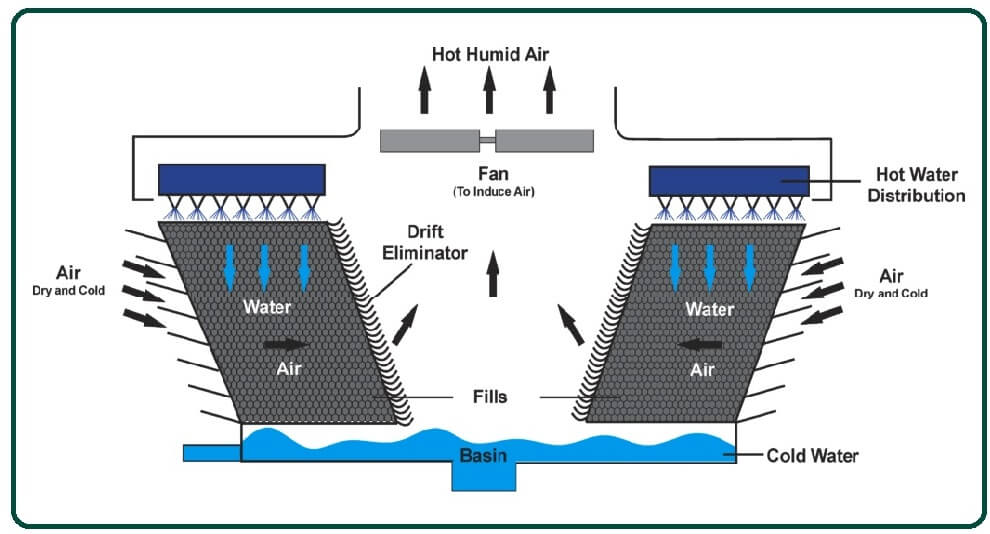
There is a design that allows air to flow horizontally through the filler and tower structure into an open plenum area. Hot water flows downstream from the distribution basins. However, fans and motor drives require weather-proofing against moisture, which can make freezing less efficient.
#5. Counterflow Cooling Tower
There is a design where the air moves upward and comes counter-current with a hot spring to cool the air. This allows maximum performance from each planning area and helps reduce pump requirements.
In addition, counterflow cooling tower systems are less likely to freeze ice in cold weather and save energy in the long run. All Delta cooling towers retract from these advantages.
#6. Inspired Draft Cooling Tower
They are usually placed on top of a cooling tower with a fan, which vents hot air and draws out the entire air. Higher exit air velocities reduce the probability of re-circulation. Discarding stream In order to avoid the entry of water droplets into the air, the flow eliminator is used.
Driven draft towers are more efficient because they use 30% to 75% less energy than forced draft designs.
Working Principle of Cooling Towers:
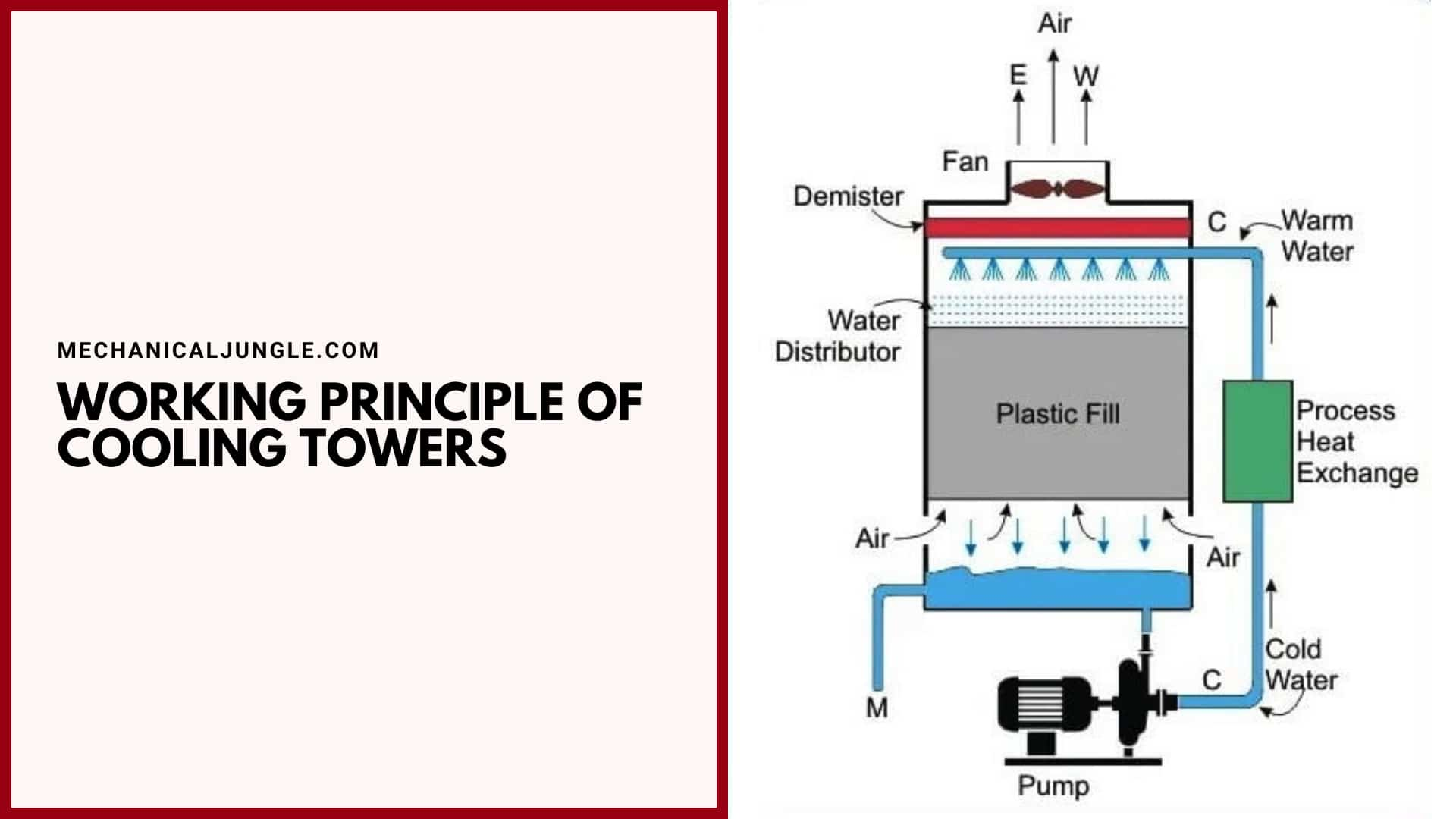
The basic working principle of cooling towers is to cool the hot water with the help of atmospheric air. However, it is widely used in various engineering fields and other refrigeration plants. The height of the cooling tower in the thermal power plant is about 9 feet or more from the ground.
A water shop unit called Talab is placed at the base of the cooling tower. In a steam power plant, the cooling tower first collects hot water from the condenser at a certain height from the ground level; then, the hot water falls down by radial spray.
Atmospheric air that is relatively quiet enters the lower part of the tower. Now the hot air in the cooling towers exposes atmospheric air, which reduces the temperature of the hot water by partial evaporation.
This cold water is collected in the pond at the base of the tower and pumped into the condenser for further use. Cooling towers operate on the principles of evaporative cooling. When the air comes in contact with hot water, it takes away the latent heat of the water and cools it.
Also, after taking heat from hot water, the air temperature rises, and it evaporates some of the water, and it cools water to a lower temperature.
Advantages of Cooling Towers:
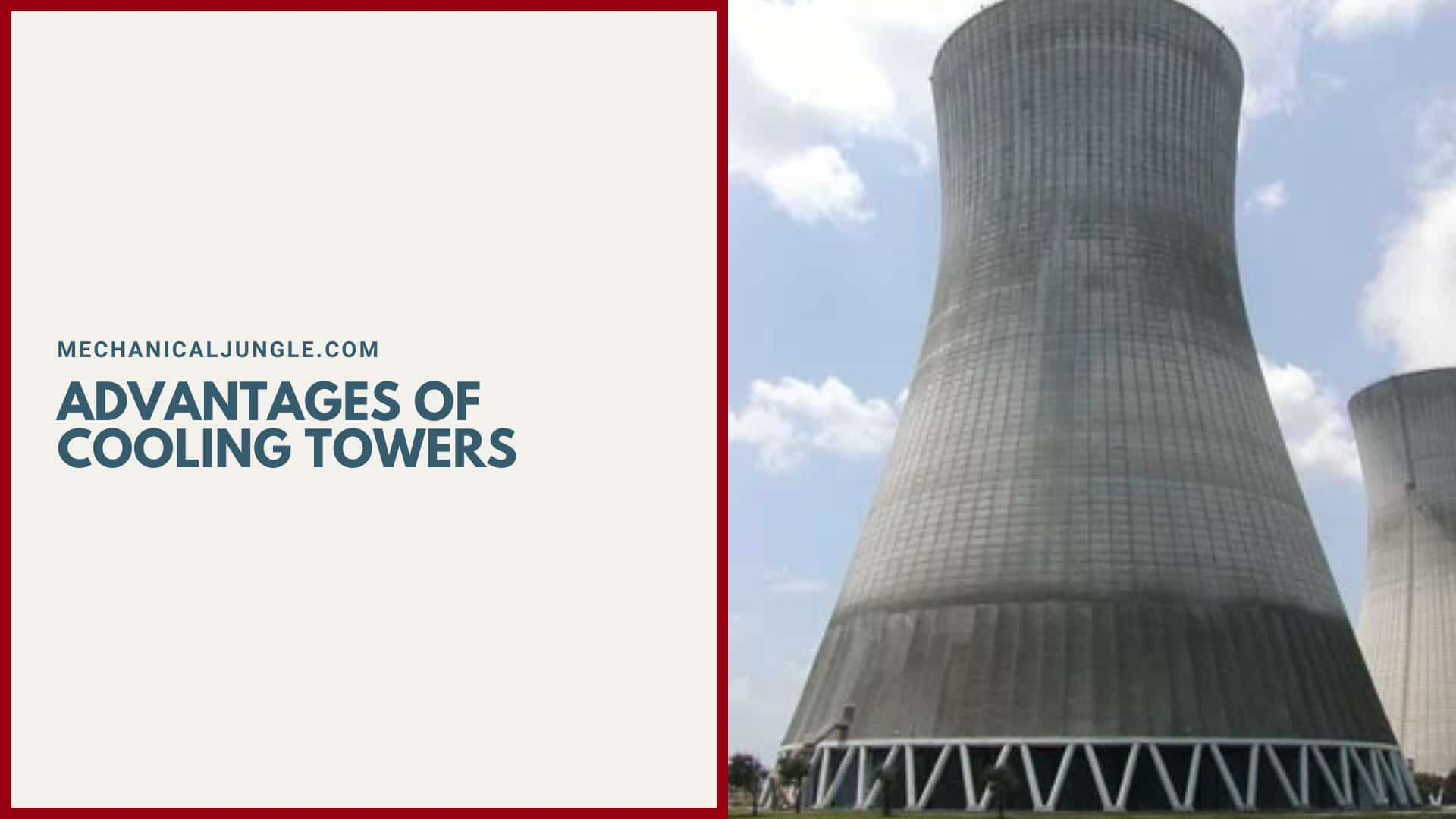
Here, the different advantages of cooling towers are as follows
- Compared to natural draft cooling towers, they are more effective.
- These towers have higher cooling rates.
- These towers are smaller in size than natural draft towers.
Frequently Asked Questions (FAQ)
What Is a Cooling Tower?
A cooling tower is a specialized heat exchanger in which air and water are brought into direct contact with each other to reduce the water’s temperature. Water, which has been heated by an industrial process or an air conditioning condenser, is pumped through the cooling tower where it is cooled by the process of evaporation.
How Does a Cooling Tower Work?
A cooling tower works by circulating hot water through nozzles into the tower where it is exposed to air. As the water flows over a material called “fill,” it is slowed down, allowing for maximum air-to-water contact. The air, pulled through the tower by a fan, causes a small amount of water to evaporate, which cools the remaining water. This cooled water is then recirculated back into the system to absorb more heat.
What Are the Main Types of Cooling Towers?
Cooling towers are classified by the type of draft (natural or mechanical) and the direction of airflow (counterflow or crossflow). The main types include:
- Natural Draught Cooling Towers
- Forced Draught Cooling Towers
- Mechanical Draft Cooling Towers
- Crossflow Cooling Towers
- Counterflow Cooling Towers
- Induced Draft Cooling Towers
What Is the Difference Between Natural Draft and Mechanical Draft Cooling Towers?
Natural draft cooling towers rely on natural convection to circulate air through the tower, while mechanical draft cooling towers use fans to move air. Mechanical draft towers can be further divided into forced draft and induced draft towers, based on the fan’s placement.
What Is the Role of the Fill in a Cooling Tower?
The fill in a cooling tower is a material that slows down the water flow and increases the water surface area for better air-to-water contact. This enhances the cooling process by allowing more water to evaporate.
Why Is Evaporation Important in Cooling Towers?
Evaporation is a key mechanism in cooling towers as it removes heat from the water. When water evaporates, it absorbs a significant amount of heat from the remaining water, thus lowering its temperature.
How Is the Cooled Water Used in Industrial Applications?
Cooled water from the cooling tower is recirculated to absorb heat from industrial processes or air conditioning systems. After absorbing heat, the water is pumped back to the cooling tower to be cooled again.
What Are the Advantages of Using Cooling Towers?
Some advantages of cooling towers include:
- High efficiency in heat removal
- Smaller size compared to natural draft towers
- Higher cooling rates
- Lower operating costs in certain designs
What Are Some Common Applications of Cooling Towers?
Cooling towers are used in various industries, including:
- Power plants
- Chemical processing
- Food and beverage manufacturing
- HVAC systems
- Plastic injection molding
- Metalworking and machine tools
How Can Cooling Tower Performance Be Optimized?
To optimize cooling tower performance, ensure regular maintenance, clean the fill and nozzles, check for proper fan operation, and monitor water quality to prevent scaling and biological growth.
What Is the Function of a Drift Eliminator in a Cooling Tower?
A drift eliminator reduces the amount of water that escapes with the exhaust air. It captures water droplets, preventing water loss and improving the efficiency of the cooling tower.
What Are the Environmental Considerations for Cooling Towers?
Environmental considerations include managing water usage, preventing chemical contamination, and controlling biological growth. Using efficient water treatment systems and maintaining proper operation can minimize environmental impacts.

